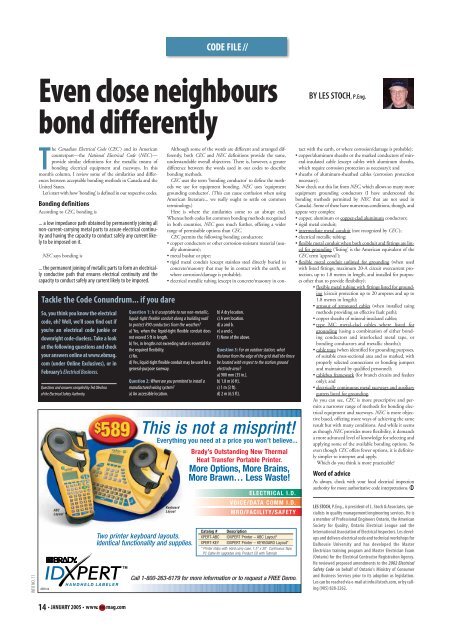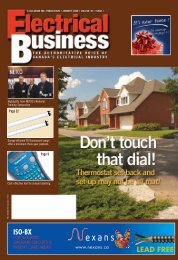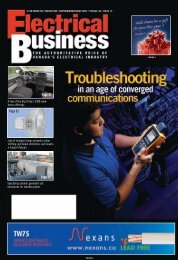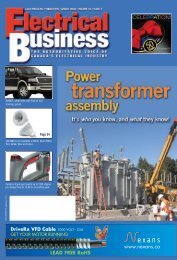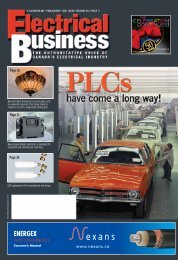January 2005.pdf - Electrical Business Magazine
January 2005.pdf - Electrical Business Magazine
January 2005.pdf - Electrical Business Magazine
- No tags were found...
Create successful ePaper yourself
Turn your PDF publications into a flip-book with our unique Google optimized e-Paper software.
CODE FILE //Even close neighboursbond differentlyBY LES STOCH, P.Eng.INFO NO. 11The Canadian <strong>Electrical</strong> Code (CEC ) and its Americancounterpart—the National <strong>Electrical</strong> Code (NEC )—provide similar definitions for the metallic means ofbonding electrical equipment and raceways. In thismonth’s column, I review some of the similarities and differencesbetween acceptable bonding methods in Canada and theUnited States.Let’s start with how ‘bonding’ is defined in our respective codes.Bonding definitionsAccording to CEC, bonding is... a low impedance path obtained by permanently joining allnon-current-carrying metal parts to assure electrical continuityand having the capacity to conduct safely any current likelyto be imposed on it.NEC says bonding is... the permanent joining of metallic parts to form an electricallyconductive path that ensures electrical continuity and thecapacity to conduct safely any current likely to be imposed.Tackle the Code Conundrum... if you dareSo, you think you know the electricalcode, eh? Well, we’ll soon find out ifyou’re an electrical code junkie ordownright code-clueless. Take a lookat the following questions and checkyour answers online at www.ebmag.com (under Online Exclusives), or inFebruary’s <strong>Electrical</strong> <strong>Business</strong>.Questions and answers compiled by Ted Olechnaof the <strong>Electrical</strong> Safety Authority.AEB104ABCLayoutQuestion 1: Is it acceptable to run non-metallic,liquid-tight flexible conduit along a building wallto protect R90 conductors from the weather?a) Yes, when the liquid-tight flexible conduit doesnot exceed 5 ft in length.b) Yes, in lengths not exceeding what is essential forthe required flexibility.c) No.d) Yes, liquid-tight flexible conduit may be used for ageneral-purpose raceway.Question 2: Where are you permitted to install amanufactured wiring system?a) An accessible location.This is not a misprint!Everything you need at a price you won’t believe...KeyboardLayoutTwo printer keyboard layouts.Identical functionality and supplies.b) A dry location.c) A wet location.d) a and b.e) a and c.f) None of the above.Question 3: For an outdoor station, whatdistance from the edge of the grid shall the fencebe located with respect to the station groundelectrode area?a) 900 mm (35 in.).b) 1.8 m (6 ft).c) 1 m (3 ft).d) 2 m (6.5 ft).Brady’s Outstanding New ThermalHeat Transfer Portable Printer.More Options, More Brains,More Brawn… Less Waste!ELECTRICAL I.D.VOICE/DATA COMM I.D.MRO/FACILITY/SAFETYCatalog # DescriptionXPERT-ABC IDXPERT Printer – ABC Layout*XPERT-KEY IDXPERT Printer – KEYBOARD Layout** Printer ships with: Hard carry case, 1.5" x 30' Continuous Tape,PC Cable for upgrades only, Product CD with TutorialsCall 1-800-263-6179 for more information or to request a FREE Demo.Although some of the words are different and arranged differently,both CEC and NEC definitions provide the same,understandable overall objectives. There is, however, a greaterdifference between the words used in our codes to describebonding methods.CEC uses the term ‘bonding conductor’ to define the methodswe use for equipment bonding. NEC uses ‘equipmentgrounding conductor’. (This can cause confusion when usingAmerican literature... we really ought to settle on commonterminology.)Here is where the similarities come to an abrupt end.Whereas both codes list common bonding methods recognizedin both countries, NEC goes much further, offering a widerrange of permissible options than CEC.CEC permits the following bonding conductors:• copper conductors or other corrosion-resistant material (usuallyaluminum);• metal busbar or pipe;• rigid metal conduit (except stainless steel directly buried inconcrete/masonry that may be in contact with the earth, orwhere corrosion/damage is probable);• electrical metallic tubing (except in concrete/masonry in contactwith the earth, or where corrosion/damage is probable);• copper/aluminum sheaths or the marked conductors of mineral-insulatedcable (except cables with aluminum sheaths,which require corrosion protection as necessary); and• sheaths of aluminum-sheathed cables (corrosion protectionnecessary).Now check out this list from NEC, which allows so many moreequipment grounding conductors (I have underscored thebonding methods permitted by NEC that are not used inCanada). Some of these have numerous conditions, though, andappear very complex:• copper, aluminum or copper-clad aluminum conductors;• rigid metal conduit;• intermediate metal conduit (not recognized by CEC );• electrical metallic tubing;• flexible metal conduit when both conduit and fittings are listedfor grounding (‘listing’ is the American equivalent of theCEC term ‘approval’);• flexible metal conduit unlisted for grounding (when usedwith listed fittings, maximum 20-A circuit overcurrent protection,up to 1.8 metres in length, and installed for purposesother than to provide flexibility);• flexible metal tubing with fittings listed for grounding(circuit protection up to 20 amperes and up to1.8 metres in length);• armour of armoured cables (when installed usingmethods providing an effective fault path);• copper sheaths of mineral-insulated cables;• type MC metal-clad cables where listed forgrounding (using a combination of either bondingconductors and interlocked metal tape, orbonding conductors and metallic sheaths);• cable trays (when identified for grounding purposes,of suitable cross-sectional area and so marked, withproperly selected connections or bonding jumpersand maintained by qualified personnel);• cablebus framework (for branch circuits and feedersonly); and• electrically continuous metal raceways and auxiliarygutters listed for grounding.As you can see, CEC is more prescriptive and permitsa narrower range of methods for bonding electricalequipment and raceways. NEC is more objectivebased, offering more ways of achieving the sameresult but with many conditions. And while it seemsas though NEC provides more flexibility, it demandsa more advanced level of knowledge for selecting andapplying some of the available bonding options. Soeven though CEC offers fewer options, it is definitelysimpler to interpret and apply.Which do you think is more practicable?Word of adviceAs always, check with your local electrical inspectionauthority for more authoritative code interpretations.LES STOCH, P.Eng., is president of L. Stoch & Associates, specialistsin quality management/engineering services. He isa member of Professional Engineers Ontario, the AmericanSociety for Quality, Ontario <strong>Electrical</strong> League and theInternational Association of <strong>Electrical</strong> Inspectors. Les developsand delivers electrical code and technical workshops forDalhousie University and has developed the MasterElectrician training program and Master Electrician Exam(Ontario) for the <strong>Electrical</strong> Contractor Registration Agency.He reviewed proposed amendments to the 2002 <strong>Electrical</strong>Safety Code on behalf of Ontario’s Ministry of Consumerand <strong>Business</strong> Services prior to its adoption as legislation.Les can be reached via e-mail at info@lstoch.com, or by calling(905) 828-2262.14 • JANUARY 2005 • www. mag.com


